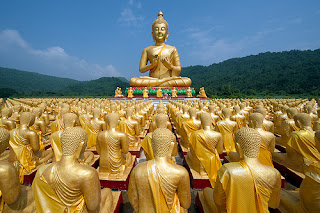Dhr. Seven, Amber Larson, Crystal Quintero, Seth Auberon, Wisdom Quarterly
 |
| The truest and funniest thing the Buddha did not say (Bodhipaksa/fakebuddhaquotes.com). |
 |
| Fake Buddha quotes often have a lovely ring and the "stink of Zen" (H-K-D/flickr.com) |
 |
| Buddha comments on Israel (SC) |
Well meaning photographer H. Kopp Delaney found a treasure store of 108 quotes and assigned them stunning photographs.
Unfortunately, some of them are of dubious origin, while others are misleadingly translated.
 |
| A very good one but fake (fakebuddhquotes.com) |
Sometimes they sound better than the real thing because rather than presenting timeless Buddhist ideas, they present New Age, Taoist, or holdover Hindu (Vedic) concepts in the guise of enlightened wisdom.
"Enlightenment" is not what most people think.
What can be done? Always be suspect of any quote not accompanied by a citation. Then before quoting, check the citation. Most quotable quotes come from The Dhammapada, a collection of Buddhist aphorisms and their origin stories providing context and meaning.
"Now are ye undeceived!" wrote Nathaniel Hawthorne in his American classic Young Goodman Brown on hypocrisy in Salem, Massachusetts during our infamous Puritan witch trials. Caveat emptor.
What is the Path?
Wisdom Quarterly (EXPLANATION)
 |
| Our goal is not to make fun of fake Buddha quotes but to distinguish path from non-path. |
 |
| Golden Buddha imparts a message of virtue, calm, and wisdom to arhats (Thai-on/flickr). |
.
 |
| Walk the path. (SadighGallery) |
- Threefold: the Buddha defines the "path" (magga) as virtue, concentration, and wisdom.
- Eightfold: he further outlines it as the Noble Eightfold Path.
- Thirty-sevenfold: gathering together many ancient sutras one finds various lists of 37 Requisites of Enlightenment.
What is VIRTUE? It is at a minimum keeping the Five Precepts, at a maximum living by the monastic rules in the context of an intensive meditation practice (the shortest path to the goal of full enlightenment in this very life). As part of the Noble Eightfold Path, it is the factors "right speech," "right action," "right livelihood."
 |
| Concentration purifies (Pranav Bhasin/flickr) |
 |
| Karma comes round (Moonbird) |
Concentration refers to the three Noble Eightfold Path factors: right effort, right mindfulness, and right concentration. (Mindfulness is interesting because it, as "bare attention," is an ingredient of concentration and, as contemplation, a subsequent practice of a concentrated mind. It leads to samadhi and goes beyond it to enlightenment; we cannot skip the first part and expect success).
 |
| Start with right view, know-and-see |
Part of meditating is coming to a point of directly seeing-and-knowing "path" from "non-path," what leads to the goal and what does not, the essential from the inessential.
There are also various super-knowledges one may attain, such as recollection of past lives or psychic powers. In terms of the Noble Eightfold Path, it refers to right view and right intention.
 |
| The first sermon to the Five Ascetics |
%2Bif%2Byou%2Bwant%2Bto%2Bknow%2Bwhere%2Byour%2Bheart%2Bis%2C%2Blook%2Bwhere%2Byour%2Bmind%2Bgoes%2Bwhen%2Bit%2Bwanders%2Bpicture24gallery%2Bblogspot%2Bcom.jpg) |
| The Buddha should have said this one (P24). |
Omniscience or "Oneness" (advaita, a Vedic/Hindu concept not talked about by the Buddha and certainly not the ultimate goal) is not what happens and is not the point. For all that MUST be penetrated fully is the truth (Fourfold Ennobling Truth) and the Three Marks of Existence mentioned above.
































































































































































































































No comments:
Post a Comment